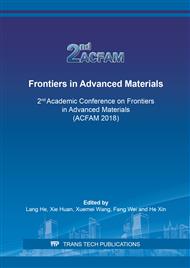p.237
p.244
p.253
p.260
p.273
p.282
p.294
p.305
p.317
Preparation of Wasted Rock Dust Catalyst and its Catalytic Ozonation Properties for the Treatment of Oxalic Acid Containing Wastewater
Abstract:
MnOx/wasted rock dust catalyst (WZ01) and modified wasted rock dust catalyst (WZ02) were prepared by impregnation method and hydrothermal method as the wasted rock dust (WRD) generated in stone processing plants was used as carriers. The structure of the two catalysts were characterized by energy dispersive spectrometer (EDS), X-ray diffraction (XRD), N2 adsorption-desorption, scanning electron microscopy (SEM) and fourier transform infrared spectroscopy (FTIR). Their removal efficiencies and reaction mechanisms of oxalic acid were compared and analyzed, which could provide an innovative perspective for catalytic efficiency improvement and cost reduction. The results showed that the WRD contained O, Si, Al, K, Mg, Fe, Ca and Na elements. Mn was amorphous in WZ01 and loaded on the surface of WRD, and Mn was in the form of orthorhombic Mn2O3 in WZ02. WZ02's surface morphology showed obvious changes and was wrinkled with many microchannels. The specific surface area, total pore volume and average pore size of WZ02 had been improved. After 30 minutes of reaction at room temperature, the removal efficiencies of oxalic acid with an initial concentration of 500 mg·L-1 were 40.6% and 54.6% by using WZ01 and WZ02 as catalysts with catalyst dosages of 2 g·L-1 and O3 concentration of 4.92 mg·L-1, respectively. The removal efficiency of oxalic acid decreased greatly after WZ01 recycling and Mn, which acted as active components, was massively washed out. The removal efficiency of oxalic acid was stable after WZ02 was triply recycled as only a small amount of Mn was washed out. The removal efficiency of oxalic acid reduced after tert butanol was introduced into the two reaction systems, and a large amount of •OH was detected by using coumarin fluorescence technology. The removal of oxalic acid by WZ01 and WZ02 catalyzed ozonation were achieved by the combination of adsorption and hydroxyl radical reaction.
Info:
Periodical:
Pages:
273-281
Citation:
Online since:
June 2019
Authors:
Keywords:
Price:
Сopyright:
© 2019 Trans Tech Publications Ltd. All Rights Reserved
Share:
Citation:


